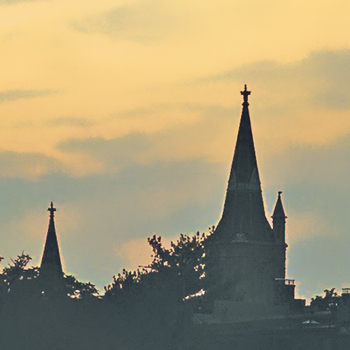 I was walking around a corner uptown today, and I startled a man who said, "I just spit! Hope you didn't step in it." A pause ensued, while I searched for an appropriate response. "Never mind," he said. "It's good luck anyhow."
I was walking around a corner uptown today, and I startled a man who said, "I just spit! Hope you didn't step in it." A pause ensued, while I searched for an appropriate response. "Never mind," he said. "It's good luck anyhow."
I love this place. So my friends have been surprised when lately I've answered their queries about my town with the response, "It's all very 'change and decay in all around I see.'"
Much of it has to do with St. George's. A glorious old pile down the street, its massive copper roof and two towers are a huge part of Shenandoah's skyline. One of the largest and oldest Lithuanian Roman Catholic church in the United States, it was just a piece of home until one day in May 2006 when the entrance and sidewalk were abruptly fenced off. "Imminent danger of the towers collapsing" was the explanation. "Maybe we should close off the streets, too?" suggested a borough councilman. No response — just the fence. Much visiting by engineers, and this spring, a tower was wrapped in netting. Not a lot of word forthcoming, just a multimillion-dollar estimate for repairs.
And in the meantime, the simple faithful are not happy.
Parish weddings and funerals are held in a church up the street which, to be very gentle, is not quite as attractive as St. George's, and which, of course, lacks the sentimental attachment. A group says a rosary for the future of the church every Wednesday. Folks attach crosses to the fence, which is a reference to the Hill of Crosses in Lithuania. That was an ongoing protest against the Soviet regime — people would pile up crosses until the Communists bulldozed the pile, and then they would start over again.
Maybe the timing has something to do with it. All of this has transpired just as the local diocese has been beginning to consolidate parishes in communities with too many churches. And since we have six Latin-rite Roman Catholic churches in a town of 6,000 (along with seven Protestant congregations of varying denominations or none), the handwriting is on the wall.
It hasn't been fun. Now that it has been announced that the actual closings will start next year, we are in a season of "lasts." Could the pain, and the waste, have been avoided?
Only if someone had been able to look far beyond the time of a booming coal economy and constant waves of fresh immigrants. But it's hard to chastise anyone for the extravagant beauty they brought to a less-than-beautiful town, even if one Lithuanian and two Polish churches might have been a bit much.
The question is — now what? And no prophet seems to be arising to look beyond our current reality, either.
And what is in this story for you? By now almost everyone has figured out that it is unwise to build a glorious pile if someone down the street with a similar mission has already built one. And we've learned that designing buildings that can be converted to other uses (should the need arise) is a good idea. Maybe it's to pray for the gift of prophecy. Maybe it's all just a reminder that until the arrival of the Kingdom, change and decay are part of the package.
But there is also a lesson in how not to close an institution — and since we tend to die as we live, in how to run one. Openness, accountability, and honesty — not to mention compassion — are virtues that can make the painful necessity less painful, and perhaps even instructive. I'm not quite sure about that last — or about the luckiness of stepping in spit, either. But this is where we live.